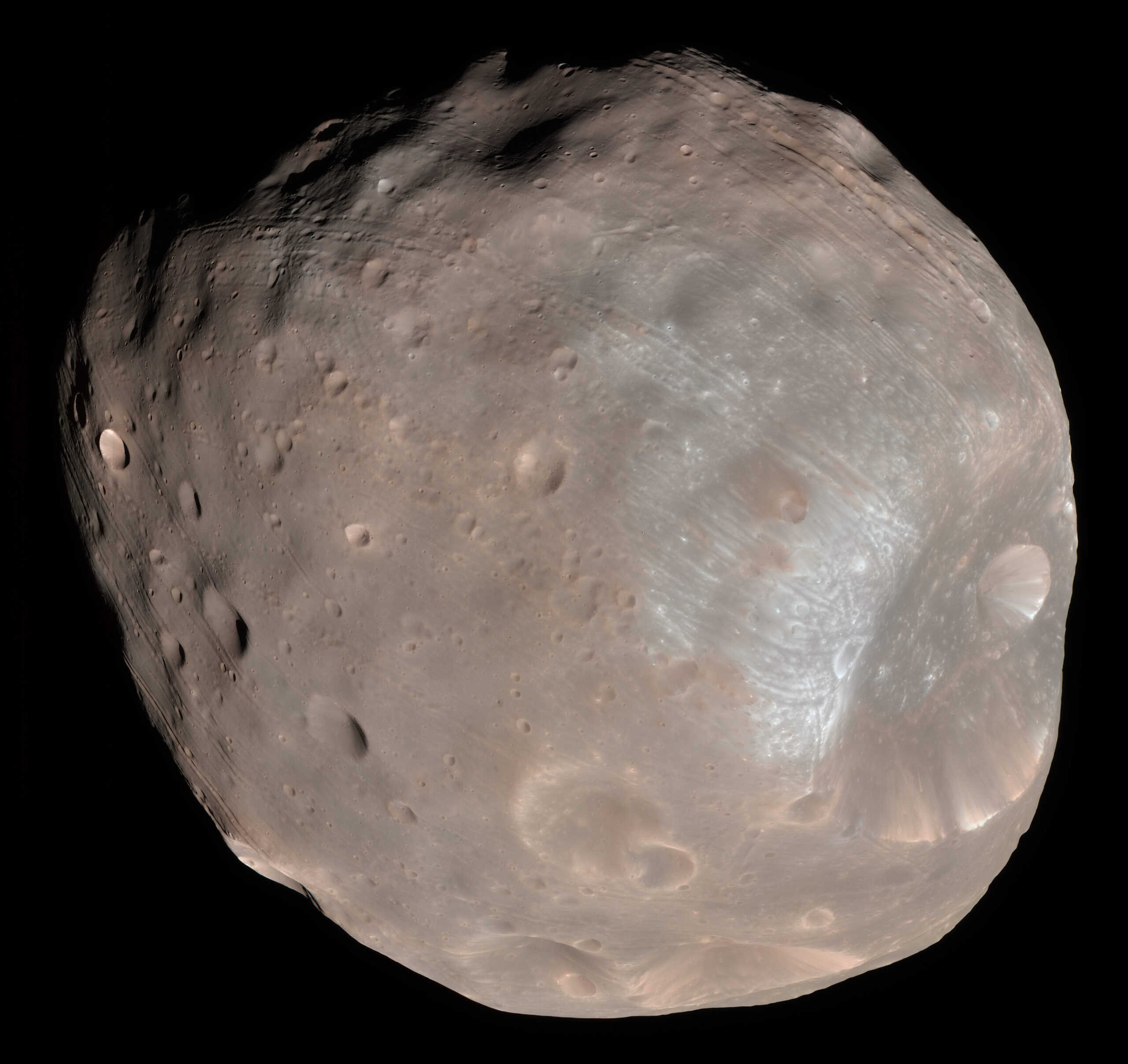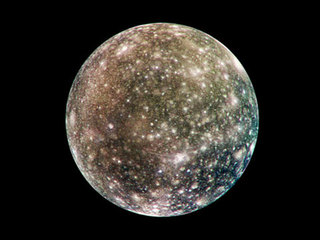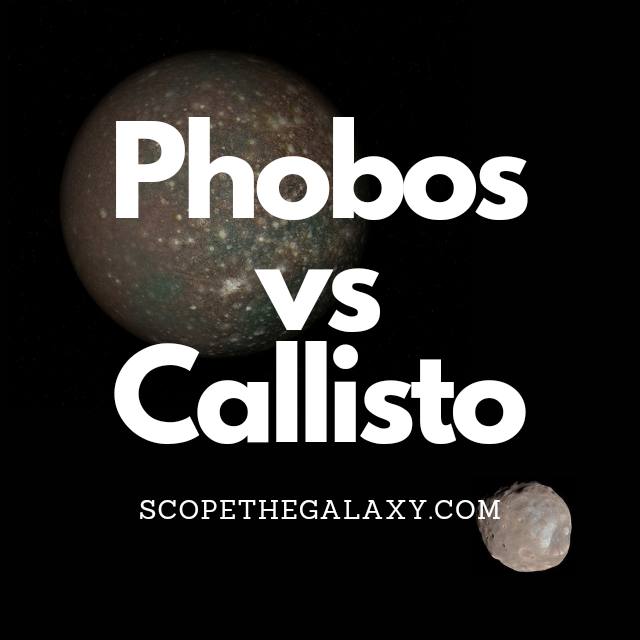*This post may contain affiliate links. This means we may make a commission if you purchase an item using one of our links*
The main differences between Phobos and Callisto are that Phobos orbits Mars while Callisto orbits Jupiter, Callisto is bigger with a diameter of 4,820.6km while Phobos has a diameter of 22.53km and Callisto is amongst the most cratered celestial bodies in our entire solar system while Phobos is not.
There are various other differences between these two so, continue reading if you want a more detailed breakdown of both bodies along with their similarities and differences below.
What Is The Moon Phobos?
Table of Contents

Phobos is the larger and innermost of the Martian moons, named after the Greek God of fear and panic. This rocky satellite measures approximately 27 x 22 x 18 kilometers and possesses an irregular shape.
Flying only 270 km above Mars’s surface, Phobos orbits the Martian surface so closely that it spins around the planet three times a day (each orbit takes 7 hours and 39 minutes). And this proximity means that the moon cannot always be seen from Mars’ surface (it all depends on where you’re standing).
In general, Phobos rises in the west, passes through the sky in around 4 hours, and sets in the east. And this process occurs twice during one Martian day.
Phobos travels 1.8 m closer to Mars every 100 years, which means this doomed moon will one day crash into its planet or break up into rings. Still, this won’t happen for another 50 million years or so.
The moon is covered in streak patterns from impact craters, the most significant of which is the crater Stickney, with a diameter of 9.7 km. Phobos has weathered thousands of meteorite impacts, one of which almost shattered it to pieces.
It was first discovered by the American astronomer Asaph Hall on 17th August 1877. But, it can be difficult for astronomers to see as it is one of the least reflective bodies in the solar system with an albedo of 0.071.
Despite its small stature, Phobos experiences wildly varying temperatures on its dark side compared to the light side. Measurements on the light side of the moon suggest that temperatures can rise to -4 degrees Celsius, a sort of brisk winter’s day that would be cold but tolerable.
In contrast, temperatures on the dark side can drop to -112 degrees Celsius, even though the two areas are just a few kilometers apart. The probable cause is fine surface dust that cannot retain heat, allowing temperatures to drop rapidly.
The low density of Phobos suggests its composition is similar to carbonaceous chondrite meteorites, which could mean that Phobos is a captured asteroid.
What Is The Moon Callisto?

Callisto is one of the large moons orbiting Jupiter, the outermost of the Galilean moons, first discovered on 7th January 1610. The surface of this icy world is frozen, but scientists believe an underground ocean could reside beneath the ice.
Even if there’s water on Callisto, it won’t necessarily hold life because the surface is so old. Scientists will need to conduct more research into the moon before determining whether this is a likely possibility.
The ESA’s JUICE (Jupiter Icy Moon Explorer) mission is focused on the three ice moons of Jupiter. It is expected to arrive in 2030 and will focus on learning more about the environment of each, as well as their potential for hosting life.
Scientists estimate that Callisto is around 4.5 billion years old (the same age as Jupiter), and its average distance from the Sun is approximately 778 million km. It has a diameter of 4,820.6km, which makes it similar in size to the planet Mercury, and the average temperature is a frigid minus 139.2 degrees Celsius.
Callisto takes seven days to orbit its planet at an average distance of 1,880,000km, and it is tidally locked, meaning the same side of it always faces Jupiter. But this moon experiences less tidal influence than the other Galilean moons because it lies in the orbit of Jupiter’s primary radiation belt.
The name of this moon is derived from the stories of Greek myth. Callisto was the nymph who had an affair with Zeus, the King of the Gods. Upon hearing this news, Zeus’ wife Hera turned Callisto into a star and placed her in the Ursa Major constellation. Interestingly, every moon of Jupiter is named after a Greek figure who Zeus seduced.
Callisto may be the third biggest moon and similar in size to the planet Mercury, but it only has a mass of 107,593,737,963.819 billion kg. That may sound like a lot, but it’s only ⅓ the mass of the similarly sized Mercury.
You may wonder why scientists classify Callisto as a “moon” rather than a planet if it’s almost the same size as Mercury. The reason is simple; planets must orbit the sun, but Callisto orbits one of the planets.
The composition of this frigid world is around 60% rock and iron and 40% ice. The moon has roughly equal amounts of rock and ice, plus the potential for water below the surface. There are also traces of carbon dioxide, organic compounds, and silicates.
This moon is one of the oldest landscapes in the Milky way and the most heavily cratered body in our system. However, scientists believe this could now be a “dead” moon as there are no longer any signs of volcanism or plate tectonics on its surface.
Similarities Between Callisto And Phobos
As both are natural satellites, Phobos and Ganymede do share a few similarities, which includes the following:
- Both have a rocky, terrestrial surface.
- Neither have rings surrounding them.
- Both are tidally locked to their planet.
- Both orbit their planet in an elliptical pattern.
- Neither have tectonic plates.
- Neither have a magnetic field.
- Callisto and Phobos have a practically non-existent axial tilt.
Differences Between Phobos And Callisto
As for the differences between the two so, they include the below:
- Phobos orbits Mars whilst the Callisto orbits Jupiter .
- Callisto is a spherical shape while Phobos is not.
- Callisto has a diameter of 4,820.6km whilst Phobos has a diameter of 22.53km.
- Phobos has no atmosphere whilst the Callisto has a very thin atmosphere composed of oxygen and hydrogen.
- A day on Phobos takes 7 hours 39 minutes whilst a Callisto day is 17 days long .
- It takes Phobos 7 hours 39 minutes to orbit Mars and around the Sun in 673 days whilst Callisto orbits Jupiter in 17 days and the Sun in 12 years.
- Phobos’ temperature ranges between -4 to -112 degrees Celsius whilst Callisto’s is between -139.2 degree Celsius.
- Callisto is amongst the most heavily cratered entities in our solar system.
- Callisto orbits Jupiter at an average distance of 1.88 million km whilst Phobos is 6,000km away from Mars.
- Callisto’s density is 1.83 g/cm³ whilst Phobo’s density is 1.88 g/cm³.
- Callisto’s mass is 1.07 x 10^23 kg whilst Phobos’ mass is 10.6 × 10^15 kg.
- Phobos’ gravitational strength is 0.0057 m/s² whilst Callisto’s is 1.236 m/s².
- Phobos only orbits Mars 6,000km away and is getting closer to the planet by 1.8 meters every 100 years.
Summary
As both are moons, they do share a fair few things such as their rocky exterior, the fact both orbit gas giants and are also tidally locked to said planets, but they are very different from each other too.
Whether it be in regards to size, mass, gravitational strength, density, the number of craters that are present within their surfaces among other things so, despite the commonalities Callisto and Phobos share, they are still easily distinguishable and can be told apart.

